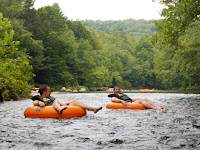As we headed down the hill we entered Stage 1, described as a typical forested wetland which has water present at or near the surface for most of the year. The ground definitely looked like it would normally be swampy but with our current drought the ground was,at best,damp. The Marsh Marigold with its buttercup-like flowers were flourishing.
As we continued along the marked trail, we entered the second stage filled with various types of magnolia's. Here two stoic 79yo tulip trees planted in 1936 have grown tall. The fast growing tulip tree grows perfectly straight and love moist wet forested areas. Around the base of these impressive trees are the Roseshell Azaleas planted in the 40's.
Stage 3 takes us to the conifers. The Gries Memorial Native Conifer Collection was established more recently in 1988 then the majority of the collection. It's relatively young age is a result of the previous grove of red pines secumming to an insect infestation in the early 80's. The refreshed conifer collection now includes red and white spruce, hemlocks, cedar trees and various pines.
Along the large Pond is the fourth stage, a dam responsible for the 3' deep pond. The dam built in 1934 allowed the seepage fed pond to devlop its own natural ecosystem and is host to many creatures like crayfish and tadpoles.
As we continue along the dam we reached Stage 5 filled with many deciduous trees and herbaceous species like oaks, birches, maples, dogwood and mountain laurel. Typically you would also find Eastern Hemlocks but the Asian Hemlock Wooly Adelgid insect has decimated the trees.
It was here we had an option, we could continue along the main path or deviate and follow the bog path. We decided to check out the bog and took the path to Stage 5a. A bog is a fairly uncommon feature found in Southern Connecticut. Bogs develop when glacial depressions fill with water and over time plant material accumulated and formed deposits of peat as thick as 3'. Shrubs like cranberry, highbush blueberry, and leatherleaf can be found along the bog edges. The bog was fairly dry thanks to the current drought.
The sixth stage includes native nut trees like the Hickory Tree. Their hard shell fruits are edible and provide food for many of the local wildlife. Here you could also appreciate the rocky out croppings from which much of the granite buildings on campus are built from.
As we made our way along the path we reached the one man made structure. Stage 7 was a gift by the Buck family in 1937 and is known as Buck Lodge. It's used by the college for recreational gatherings and meetings.
The eighth stage puts you under a massive White Pine planted in 1940 to replace the loss of another large pine in 1938. It sits on the edge of the outdoor theater once used by Connecticut a College for Comomencement exercises. As we admired the open area we discussed the possibility that my Grandmother who was an alum of Connecticut College may have received her diploma in that very spot.
The final stage, stage 9 is the home to the arboretum's native Holly collection. With both male and female trees I have never seen such big holly trees. The female trees have red berries where the male trees do not.
That wrapped up our self-guided tour of this impressive collection of native plants on this beautiful late summer early fall day.






















































